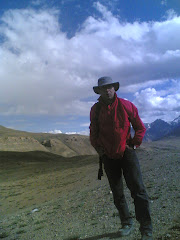The compelling need for the protection of Himalayan environment
 The Highly Endangered Himalayan Snow Leopard (Panthera uncia)
The Highly Endangered Himalayan Snow Leopard (Panthera uncia)- Most of our country’s delicate mountain ecosystems are in the throes of a serious ecological crisis right now. The population of India is increasing exponentially and human habitation is growing by leaps and bounds, even in those areas that were hitherto considered remote and inhospitable. Areas like the Himalayan Mountain regions. The primary repercussion of this has been that the sensitive environment of these regions has had to bear the brunt of such habitation and its other associated evil; that of unsustainable development.
- Deforestation has acquired alarming proportios at many places and has given rise to severe erosion and siltation of the Himalayan rivers: Leading, in turn, to big problems in the upper and lower catchment areas of these rivers. The increased need for more and more cultivable agricultural land and the heightened requirement for timber (for fuelwood and construction purposes), have only served to exacerbate the problem. For this has meant that more virgin forests have come under the axe. Crises in watershed management are prevalent in many of these mountainous areas, and catastrophes like flash floods and landslides have become much more frequent over the years.
- This indiscriminate and unlimited deforestation has also translated into
 a severe depletion of habitat for many species of native Himalayan flora and fauna, which are now on the road to perdition. Already, beautiful and rare species of trees like the Silver oak and Bhojpatra… and splendid animals, like the Snow leopard, Ibex, Markhor and the Himalayan Brown Bear, are tottering over the verge of the abyss of extinction. But, mindless of all this, the heartless juggernaut of human progression and 'Lopsided… anthropocentric development' rumbles on relentlessly. Crushing beneath its merciless wheels, the right to survival of all the other ‘children of the earth.’ Ravaging their realms and stamping out their very existence.
a severe depletion of habitat for many species of native Himalayan flora and fauna, which are now on the road to perdition. Already, beautiful and rare species of trees like the Silver oak and Bhojpatra… and splendid animals, like the Snow leopard, Ibex, Markhor and the Himalayan Brown Bear, are tottering over the verge of the abyss of extinction. But, mindless of all this, the heartless juggernaut of human progression and 'Lopsided… anthropocentric development' rumbles on relentlessly. Crushing beneath its merciless wheels, the right to survival of all the other ‘children of the earth.’ Ravaging their realms and stamping out their very existence.
- However, in this blind race of blatant avarice, commercial exploitation and profiteering, our foresight seems to have abandoned us. The unmitigated destruction of Himalayan forests coupled with the indiscriminate use of fossil fuels has, in turn, led to a magnification of the global greenhouse effect at the local level: Consequently there is now an unmistakable change, for the worse, in the microclimates of these places. This has started a chain reaction. The substantially increased temperatures and a significant decrease in winter precipitation (in the form of snow), have led to a massive and rapid melting process in all the major glaciers in this region. This phenomenon is called Glacial Recession and is normal to a certain extent. Under the present circumstances though, the rate of recession (or melting) of the Himalayan glaciers, is abnormally high and that is a very ominous development. This is not an alarmist doomsday prophecy… the facts speak for themselves:
- Most of the rivers in North India are of glacial origin and everywhere their sources, (which are either glaciers of glacier fed lakes) are rapidly depleting. The Ganga, which is the lifeline of India and on whose shores one tenth of the world’s population dwells, is a perfect case to the point. The Gangotri Glacier, which is the source of this magnificent river, is receding at the average rate of a whopping 27 to 30 Meters per year. Most of the rivers in North India are of glacial origin and everywhere their sources (Glaciers or glacial lakes) are drying up an disappearing rapidly.

At this speed, according to eminent Glacier Hydrology Experts, the glacier will disappear totally within the next 25 years. So, what we are basically looking at is the prospect of the Ganga turning into a seasonal river in three decades time. It is the same story with most of the other rivers of north India. What this means simply put… is that the whole of north India at least will, in all probability, turn into a vast desert in the foreseeable future.
- Another factor aggravating the above tragedy, is the continual increase in the influx of tourists and adventure sports enthusiasts into these mountains: Though this has come as a boon for the residents of these areas and has undoubtedly led to their economic well being, it is unsustainable in the long run and it is just a matter of time before this boon turns into a bane for these places. With the concept of ‘Eco –Tourism’ yet to take root and germinate in these regions, unregulated and unbalanced tourist activity is proving to be the proverbial ' Last straw on the camels back', of this already growing ecological disaster
 Himalayan Bhojpatra
Himalayan Bhojpatra .jpg)